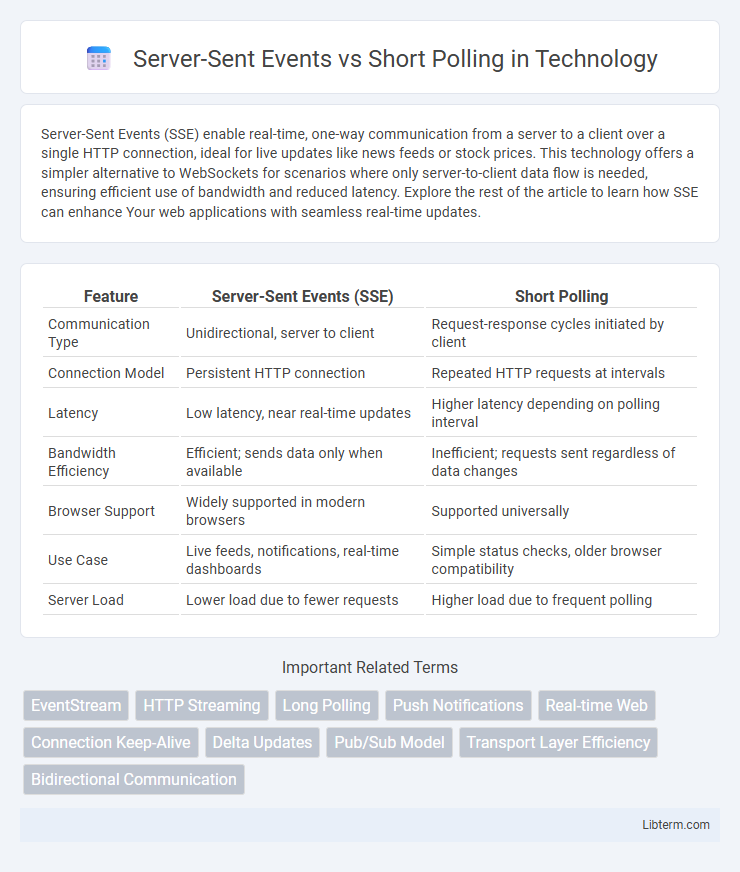Server-Sent Events (SSE) enable real-time, one-way communication from a server to a client over a single HTTP connection, ideal for live updates like news feeds or stock prices. This technology offers a simpler alternative to WebSockets for scenarios where only server-to-client data flow is needed, ensuring efficient use of bandwidth and reduced latency. Explore the rest of the article to learn how SSE can enhance Your web applications with seamless real-time updates.
Table of Comparison
| Feature | Server-Sent Events (SSE) | Short Polling |
|---|---|---|
| Communication Type | Unidirectional, server to client | Request-response cycles initiated by client |
| Connection Model | Persistent HTTP connection | Repeated HTTP requests at intervals |
| Latency | Low latency, near real-time updates | Higher latency depending on polling interval |
| Bandwidth Efficiency | Efficient; sends data only when available | Inefficient; requests sent regardless of data changes |
| Browser Support | Widely supported in modern browsers | Supported universally |
| Use Case | Live feeds, notifications, real-time dashboards | Simple status checks, older browser compatibility |
| Server Load | Lower load due to fewer requests | Higher load due to frequent polling |
Introduction to Real-Time Communication Techniques
Server-Sent Events (SSE) provide a unidirectional, persistent connection where servers push real-time updates to clients efficiently using HTTP. Short Polling involves clients frequently sending requests at regular intervals to check for new data, resulting in increased latency and server load. SSE is optimized for scenarios requiring continuous streaming of updates, while Short Polling suits simpler, less time-sensitive applications.
What Are Server-Sent Events (SSE)?
Server-Sent Events (SSE) is a web technology enabling servers to push real-time updates to browsers over a single, long-lived HTTP connection. Unlike short polling, which repeatedly sends HTTP requests at intervals, SSE provides a persistent connection allowing continuous event streaming with reduced latency and lower network overhead. SSE supports automatic reconnection and event ID tracking, enhancing reliability for applications like live sports scores, stock tickers, and social media feeds.
Understanding Short Polling
Short Polling is a client-driven technique where the client repeatedly sends requests to the server at regular intervals to check for new data, resulting in increased latency and resource usage compared to Server-Sent Events (SSE). Each poll creates a new HTTP connection, causing unnecessary overhead and potential delays in data delivery. This method is less efficient for real-time applications, especially when immediate data updates are critical.
How Server-Sent Events Work
Server-Sent Events (SSE) allow a server to push real-time updates to clients over a single, long-lived HTTP connection using the EventSource API. Unlike short polling, which repeatedly sends HTTP requests to check for updates, SSE maintains an open connection where the server continuously streams data as new events occur. This approach reduces unnecessary network traffic and latency, providing efficient, one-way communication ideal for live notifications and data feeds.
How Short Polling Operates
Short Polling operates by the client repeatedly sending HTTP requests to the server at fixed intervals to check for new data, resulting in increased latency and unnecessary network overhead when no updates are available. Each request-response cycle establishes a new connection, causing higher CPU usage and potential scalability issues on both client and server sides. This method contrasts with Server-Sent Events, which allow the server to push updates to the client over a single long-lived connection, improving efficiency and real-time performance.
Key Differences Between SSE and Short Polling
Server-Sent Events (SSE) provide a unidirectional, real-time data stream from the server to the client using a single persistent HTTP connection, minimizing latency and reducing server load compared to short polling. Short polling repeatedly sends HTTP requests at fixed intervals to check for new data, causing higher network overhead and increased server resource consumption. SSE uses an event-driven approach with lower bandwidth usage, while short polling relies on continuous request-response cycles that can lead to delayed updates and inefficiency.
Performance and Scalability Comparison
Server-Sent Events (SSE) offer superior performance over short polling by maintaining a persistent connection that allows real-time, low-latency data streaming from the server to the client, reducing overhead caused by frequent HTTP requests. Short polling repeatedly sends HTTP requests at fixed intervals, leading to increased server load and network congestion as client numbers grow, which negatively impacts scalability. SSE scales efficiently in applications with many concurrent clients due to lower resource consumption per connection and minimized redundant data transfer.
Use Cases for Server-Sent Events
Server-Sent Events (SSE) excel in use cases requiring real-time updates from the server to the client, such as live sports scores, stock market feeds, or social media notifications. Unlike short polling, SSE maintains a single persistent connection, reducing latency and server load while ensuring timely delivery of continuous data streams. This makes SSE ideal for applications demanding efficient, low-overhead, one-way communication from server to browser.
Use Cases for Short Polling
Short polling is suitable for applications requiring simple, periodic data updates where low latency is not critical, such as checking for new emails or status updates in user dashboards. It works well in environments with limited server support for persistent connections or where implementing Server-Sent Events (SSE) is not feasible due to infrastructure constraints. Short polling provides straightforward implementation with broad compatibility across HTTP clients, making it ideal for legacy systems or when minimal server-side changes are preferred.
Choosing the Right Approach for Your Application
Server-Sent Events (SSE) provide a persistent, low-latency connection ideal for real-time updates in applications with high-frequency data streams, reducing server load and network overhead compared to Short Polling. Short Polling, while simpler to implement, involves repeated HTTP requests at regular intervals, increasing latency and server resource consumption, making it suitable for applications with less frequent updates or limited server capabilities. Evaluating factors such as update frequency, server scalability, network conditions, and client support is critical in choosing between SSE and Short Polling to optimize performance and user experience.
Server-Sent Events Infographic

 libterm.com
libterm.com